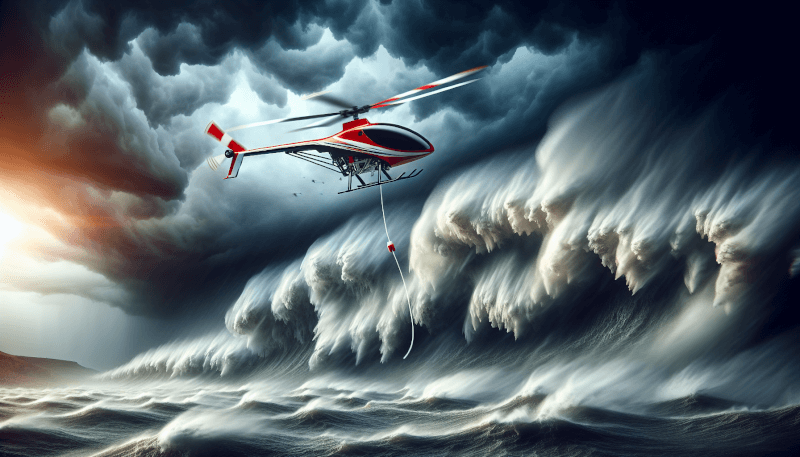Are you an avid RC helicopter enthusiast? Have you ever been deterred from flying your beloved toy due to a gusty breeze? Fear not, for this article will provide you with valuable tips on how to confidently navigate your RC heli in windy conditions. From adjusting your controls to understanding wind patterns, these expert-approved techniques will ensure a smooth and enjoyable flying experience, no matter how blustery it gets. So strap in and get ready to conquer the wind!
Choosing the Right RC Heli
When it comes to choosing the right RC heli, there are a few important factors to consider. The size and weight of the helicopter are crucial to ensure stability and maneuverability during flight. A larger, heavier helicopter may be more stable in windy conditions, but it can also be more difficult to control. On the other hand, a smaller and lighter helicopter may be easier to handle, especially for beginners. It’s important to find the right balance between size and weight that matches your skill level and flying preferences. Additionally, look for stability features such as gyroscopes or stabilizers that can help improve the helicopter’s stability and responsiveness in the air.
Pre-flight Preparations
Before taking your RC heli out for a flight, it’s essential to make some pre-flight preparations to ensure a smooth and safe experience. First, check the weather forecast to determine whether it is suitable for flying. Strong winds or unfavorable weather conditions can make flying difficult and potentially dangerous. Next, thoroughly inspect the helicopter for any damage or loose parts that could affect its performance. Look for any cracks, dents, or broken components, and if any issues are found, make the necessary repairs or replacements before flying. It’s also important to secure any loose parts, such as rotor blades or landing gears, to prevent them from detaching during flight. Finally, adjust the control settings according to your preferences and flying style. This includes adjusting the trim, rates, and expo settings to match your skill level and flight conditions.

Understanding Wind Conditions
When flying an RC heli, understanding wind conditions is crucial for safe and enjoyable flights. Wind speed and direction play a significant role in how the helicopter behaves in the air. It’s essential to learn how wind affects the helicopter’s flight characteristics and adjust your flying techniques accordingly. Additionally, it’s important to identify gusts and turbulence, which can be challenging to fly in. Gusts are sudden bursts of wind that can cause the helicopter to lose control or change its flight path unexpectedly. Turbulence refers to the irregular air movements caused by factors such as buildings, trees, or other obstructions. By being aware of these wind conditions, you can anticipate and adapt to them during your flights.
Takeoff and Landing Techniques
To ensure a smooth takeoff and landing, it’s important to follow proper techniques. When taking off with an RC heli, it’s best to use a runway or a flat surface free from obstacles. This provides a clear path for the helicopter to lift off without any interfering objects. Additionally, taking off into the wind is recommended as it helps provide additional lift and stability to the helicopter. Landing into the wind is also preferred as it helps slow down the helicopter’s forward motion and provides better control during the landing process. By following these techniques, you can achieve controlled and safe takeoffs and landings with your RC heli.

Flying Techniques
When it comes to flying your RC heli, there are several techniques that can help you maximize control and stability during flights. Firstly, fly with the wind whenever possible. This means flying in the same direction as the wind, as it can provide additional lift and make it easier to maneuver the helicopter. Secondly, use smaller control inputs to maintain precise control over the helicopter’s movements. Sudden or large control inputs can result in erratic and unpredictable behavior, especially in windy conditions. Instead, make gentle and smooth adjustments to achieve the desired flight path. Avoid sudden movements and instead focus on maintaining consistent altitude and heading. Finally, practicing hovering is essential to develop your control and stabilization skills. It allows you to keep the helicopter in a stationary position in the air by precisely adjusting the throttle and control inputs. By mastering these flying techniques, you can confidently navigate your RC heli in various wind conditions.
Managing Gusts and Turbulence
While flying your RC heli, it’s important to stay alert and anticipate gusts and turbulence. Gusts can suddenly impact the helicopter’s stability and could lead to unpredictable flight behavior. By staying attentive to your surroundings and being prepared for gusts, you can make quick adjustments to maintain control. Reacting quickly and making necessary control inputs can help counteract the effects of gusts and regain stability. Additionally, avoid flying near obstacles, such as buildings or trees, that can create turbulence. Turbulence can disrupt the airflow around the helicopter, making it difficult to control and potentially causing crashes. By keeping a safe distance from obstacles, you can minimize the impact of turbulence on your flights and ensure a smoother flying experience.

Emergency Procedures
While flying an RC heli, it’s crucial to be prepared for unexpected issues that may arise. Despite taking all necessary precautions, accidents or malfunctions can happen. It’s important to know how to initiate an emergency landing in case of any problems during flight. Practice emergency landing procedures to ensure you can safely bring down the helicopter if needed. This may include finding a suitable landing spot, reducing speed, and controlling the descent rate to avoid any damage to the helicopter or surrounding property. By being prepared and knowing what to do in an emergency, you can minimize any potential harm or damage.
Battery and Flight Time Considerations
Choosing the right battery for your RC heli is essential for optimal performance and flight time. Consider factors such as capacity, voltage, and discharge rate when selecting a battery. A higher capacity battery will provide longer flight times, but it may also increase the weight of the helicopter, affecting its stability. Similarly, a higher voltage battery can enhance the helicopter’s power and responsiveness but may require additional safety measures. Monitoring flight time and battery voltage during flights is crucial to prevent sudden power failures or mid-air crashes. Use a reliable timer or telemetry system to keep track of flight duration and battery voltage to ensure a safe and enjoyable flying experience.

Flight Safety and Regulations
When flying an RC heli, it’s essential to follow local rules and regulations to ensure safety for yourself and others. Familiarize yourself with any laws or guidelines regarding RC helicopter flying in your area. This may include restrictions on flight altitude, flying in public spaces, or maintaining a safe distance from people and property. Additionally, it’s important to maintain a safe distance from others while flying to avoid any accidents or injuries. Being responsible and respectful of the rules and regulations not only ensures a safe flying experience but also promotes a positive image of the RC helicopter community.
Post-flight Maintenance
After each flight, it’s crucial to conduct post-flight maintenance to keep your RC heli in good condition. Inspect the helicopter for any damage or wear and tear that may have occurred during the flight. Look for any cracks, loose parts, or signs of stress on the helicopter’s frame or components. If any issues are found, address them promptly by repairing or replacing the damaged parts. Additionally, clean the helicopter, especially the rotor blades, to remove any dirt or debris that may have accumulated during flight. Properly storing the helicopter, such as in a protective case or bag, can help prevent damage and ensure it remains in optimal condition for your next flight. By performing regular maintenance, you can prolong the lifespan of your RC heli and enjoy many more trouble-free flights in the future.
In conclusion, choosing the right RC heli and understanding wind conditions are crucial for safe and enjoyable flying experiences. By following proper takeoff and landing techniques, mastering flying techniques, and managing gusts and turbulence, you can navigate your RC heli with confidence. It’s important to be prepared for emergencies, monitor battery and flight time, and adhere to safety regulations to ensure a safe and responsible flying experience. Additionally, conducting post-flight maintenance will help keep your RC heli in optimal condition for countless flights to come. So, grab your RC heli, take to the skies, and enjoy the thrill of piloting your very own aircraft!



